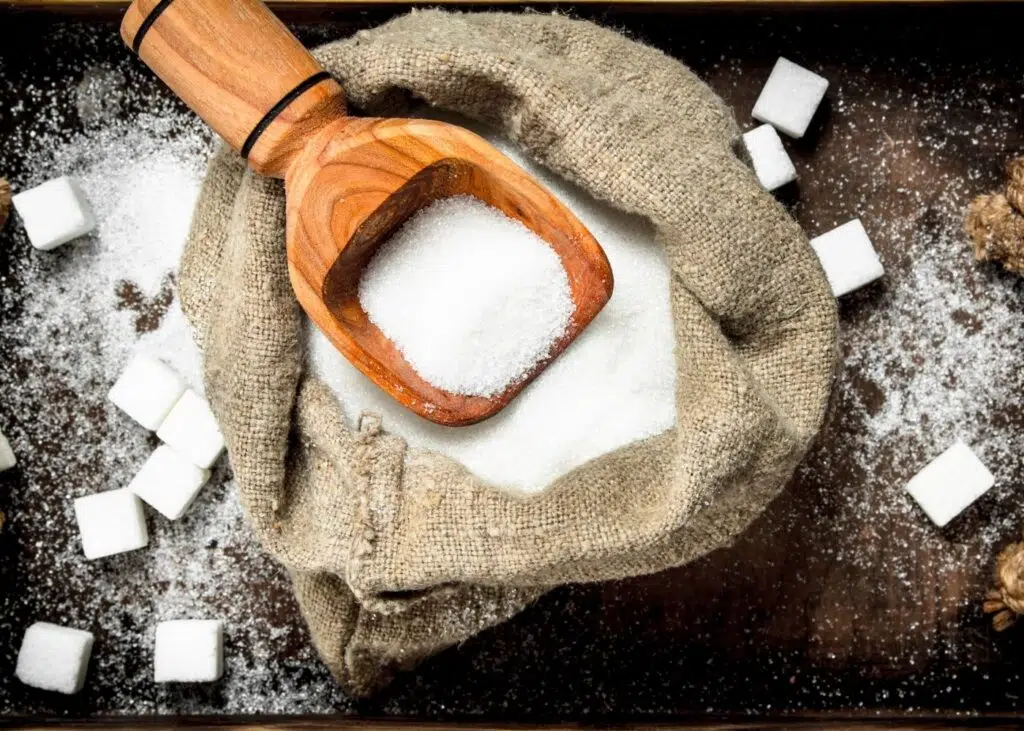Hi friends!
You’ve probably heard the terms fructose, glucose, lactose and sucrose before, and you may know that they’re all types of sugar. But do you know how they differ from one another? If you’re trying to cut back on sugar, you are also probably wondering whether the type of sugar matters.
Let’s start from the beginning. They are all found naturally in fruits, vegetables, dairy products and grains but also added to many processed foods.
However, they differ in their chemical structures, the way your body digests and metabolizes them and how they affect your health.The first fact that you have to realise is that they are all carbohydrates. Carbohydrates are classified into two basic groups, complex and simple.
Complex carbohydrates
Are composed of multiple simple sugars, joined together by chemical bonds. The more chains and branches of simple sugars, the more complex a carbohydrate is and in turn, the longer it takes to be broken down by the body and the less impact it has on blood sugar levels. Examples of complex carbohydrates include wholegrains such as jumbo oats, brown rice, spelt, rye and barley. (1)
Simple carbohydrates
Are either monosaccharides (one sugar molecule) or disaccharides (two sugar molecules). They are digested quickly and release sugars rapidly into the bloodstream. The two main monosaccharides are glucose and fructose. The two major disaccharides are sucrose (composed of glucose and fructose) and lactose (which is made up of galactose and glucose). (1)

Glucose (C6H12O6 ) – is the primary source of energy your body uses and every cell relies on it to function. When we talk about blood sugar we are referring to glucose in the blood. When we eat carbohydrates, our body breaks them down into units of glucose. When blood glucose levels rise, cells in the pancreas release insulin, signalling cells to take up glucose from the blood. As the cells absorb sugar from the blood, levels start to drop. (1)
Glucose is also known as dextrose, corn sugar and grape sugar. Glucose is the most abundant monosaccharide in the world and the key energy molecule for Earth’s organisms. While it’s needed for many functions, glucose is particularly important because it supplies nearly all the energy for the human brain. (2)
The glycemic index is a ranking of how quickly foods make your blood sugar levels rise after eating them. High GI foods are very easily broken down into glucose. Glucose is the defining standard and has a GI value of 100. Glucose alone does not taste particularly sweet compared to fructose and sucrose.
Research suggests that, as glucose stimulates insulin release from the pancreas, it also results in the release of two other hormones, leptin and ghrelin. Leptin is known as the appetite suppressor and ghrelin the appetite increaser. It is thought that lower GI foods (such as wholegrains, proteins and those lower in glucose) suppress ghrelin, therefore regulating satiety. (1) (3)

Fructose – (C6H12O6) or fruit sugar, is a simple monosaccharide found in many plants, fruit, honey, sucrose and high fructose corn syrup. Most fructose can be commercially produced as a component of high-fructose corn syrup. It is used in food manufacturing because it is cheap and effective as a flavoring and preservative. High-fructose corn syrup is made from cornstarch and contains more fructose than glucose, compared to regular corn syrup. (4)
Fructose is very sweet, roughly one-and-a-half times sweeter than sucrose (white sugar).
Fructose is absorbed directly into the bloodstream during digestion and has no impact on insulin production or blood glucose levels. Consequently, its GI value is much lower, on average around 19. (1)
Fructose is handled by the body in a different way to glucose as it is metabolised in the liver. As a result, blood sugar (glucose) levels do not rise as rapidly after fructose consumption compared to other simple sugars. When you eat too much fructose the liver cannot process it fast enough and instead, starts to make fats that are carried in the blood and stored as triglycerides – the body’s main form of fat. Studies have shown that the consumption of large amounts of fructose may lead to increased appetite by impairing the body’s ability to use insulin and to suppress circulating ghrelin (the appetite-stimulating hormone). (5) (6)
While most diabetics cannot tolerate sucrose, most can tolerate moderate amounts of fruit and fructose without loss of blood sugar control. Research is yet to show any detrimental health effects of moderate consumption of fructose as part of a balanced diet. However, it’s worth keeping in mind that the excessive consumption of HFCS and other sweeteners may contribute to elevated blood sugar levels, blood fats and subsequent weight gain. (7) (8)

Sucrose (C12H22O11) – is the organic compound commonly known as table sugar and sometimes called saccharose produced by the sugar cane plant. The molecule is a disaccharide made up of 50% glucose and 50% fructose and is broken down rapidly into its constituent parts.
Due to its glucose content, sucrose has a GI value of 65. As it is made up of glucose and fructose, the latter is metabolised in the liver and holds the same issues as those mentioned for fructose above. Due to its glucose content, sucrose does lead to an elevation in blood glucose. Diabetics should therefore be mindful of foods containing sucrose.
Lactose (C12H22O11) – is the sugar found in milk. It is a disaccharide made up of glucose and galactose units. It is broken down into the two parts by an enzyme called lactase. Once broken down, the simple sugars can be absorbed into the bloodstream.
Whole milk has a GI value of 41 and is considered to be a low GI food. It is broken down slowly and helps to increase the absorption of minerals such as calcium, magnesium and zinc. Some people experience lactose intolerance – an inability to produce the lactase enzyme that breaks down milk. Lactose intolerance can lead to diarrhoea, bloating and other gastrointestinal symptoms. (9)

What are the major food types that contain Fructose and Sucrose?
| Food Item | TotalCarbohydrate | TotalSugars | FreeFructose | FreeGlucose | Sucrose | Fructose/GlucoseRatio | Sucroseas a % ofTotal Sugars |
| Fruits | |||||||
| Apple | 13.8 | 10.4 | 5.9 | 2.4 | 2.1 | 2.0 | 19.9 |
| Apricot | 11.1 | 9.2 | 0.9 | 2.4 | 5.9 | 0.7 | 63.5 |
| Banana | 22.8 | 12.2 | 4.9 | 5.0 | 2.4 | 1.0 | 20.0 |
| Fig, dried | 63.9 | 47.9 | 22.9 | 24.8 | 0.07 | 0.93 | 0.001 |
| Grapes | 18.1 | 15.5 | 8.1 | 7.2 | 0.2 | 1.1 | 1.0 |
| Peach | 9.5 | 8.4 | 1.5 | 2.0 | 4.8 | 0.9 | 56.7 |
| Pear | 15.5 | 9.8 | 6.2 | 2.8 | 0.8 | 2.1 | 8.0 |
| Pineapple | 13.1 | 9.9 | 2.1 | 1.7 | 6.0 | 1.1 | 60.8 |
| Plum | 11.4 | 9.9 | 3.1 | 5.1 | 1.6 | 0.66 | 0.16 |
| Vegetables | |||||||
| Beet, Red | 9.6 | 6.8 | 0.1 | 0.1 | 6.5 | 1.0 | 96.2 |
| Carrot | 9.6 | 4.7 | 0.6 | 0.6 | 3.6 | 1.0 | 70.0 |
| Corn, Sweet | 19.0 | 6.2 | 1.9 | 3.4 | 0.9 | 0.61 | 15.0 |
| Red Pepper, Sweet | 6.0 | 4.2 | 2.3 | 1.9 | 0.0 | 1.2 | 0.0 |
| Onion, Sweet | 7.6 | 5.0 | 2.0 | 2.3 | 0.7 | 0.9 | 14.3 |
| Sweet Potato | 20.1 | 4.2 | 0.7 | 1.0 | 2.5 | 0.9 | 60.3 |
| Yam | 27.9 | 0.5 | tr | tr | tr | na | tr |
| Sugar Cane | 13 – 18 | 0.2 -1.0 | 0.2- 1.0 | 11 – 16 | 1.0 | 100 | |
| Sugar Beet | 17 – 18 | 0.1 – 0.5 | 0.1- 0.5 | 16 – 17 | 1.0 | 100 |
What is the difference between fructose found in fruits and vegetables and fructose found in high-fructose corn syrup?
The most widely used varieties of high-fructose corn syrup are: HFCS 55 (mostly used in soft drinks), approximately 55% fructose and 42% glucose; and HFCS 42 (used in beverages, processed foods, cereals and baked goods), approximately 42% fructose and 53% glucose.
There is no difference in the molecules of sugars found in fruits or HFCS but the soluble fiber in fruit stabilizes blood sugar.
How is fructose different than sucrose when cooking of foods?
Two reactions take place in cooking that cause browning. They are the Maillard Reaction and Caramelization. (11)
Caramelization of sucrose starts with the melting of the sugar at high temperatures followed by foaming (boiling). Sucrose first decomposes into glucose and fructose. This is followed by a condensation step, in which the individual sugars lose water and react with each other. Hundreds of new aromatic compounds are formed having a range of complex flavors. (12)
Sucrose and glucose caramelize around 160C (320F) and fructose caramelizes at 110C. (230F). The highest rate of the color development is caused by fructose as caramelization of fructose starts at 110C. Baked goods made from honey or fructose syrup will therefore give a darker color.
Fructose undergoes the Maillard reaction, non-enzymatic browning, with amino acids. Because fructose exists to a greater extent in the open-chain form than does glucose, the initial stages of the Maillard reaction occurs more rapidly than with glucose. Therefore, fructose potentially may contribute to changes in food palatability, as well as other nutritional effects, such as excessive browning, volume and tenderness reduction during cake preparation. Sucrose – table sugar – is not a reducing sugar and takes no part in the Maillard Reactions (but does get involved in caramelization). (11) (12)
What is fructose malabsorption and fructose intolerance?
Fructose malabsorption, formerly named “dietary fructose intolerance,” is a digestive disorder in which absorption of fructose is impaired by deficient fructose carriers in the small intestine’s enterocytes. This results in an increased concentration of fructose in the entire intestine. Fructose malabsorption is found in up to 30% of the population of Western countries and Africa. This condition is common in patients identified to be suffering symptoms of irritable bowel syndrome, although occurrence in these patients is not higher than occurrence in the normal population. Conversely, patients with fructose malabsorption often fit the profile of those with irritable bowel syndrome. A small proportion of patients with both fructose malabsorption and lactose intolerance also suffer from celiac disease. Fructose malabsorption is not to be confused with hereditary fructose intolerance, a potentially fatal condition in which the liver enzymes that break up fructose are deficient.
I know, I know!! This is a lot to take in, but this article has extremely important information that we all should know of. The actual extremely high levels of sugar consumption worldwide should be the biggest concern to both governments as well as to all of us consumers and caretakers. Knowing which carbohydrates to avoid and which amounts to consume daily is key to pursuing a healthy life.
This article and all the information gathered here is mainly inspired by these sites: Edinformatics and BBC Good Food
Thank you all for coming by and for sharing this information with your friends and family!
I appreciate it and they will be thankful! 😉
Have a sweet week,
Leonor.
